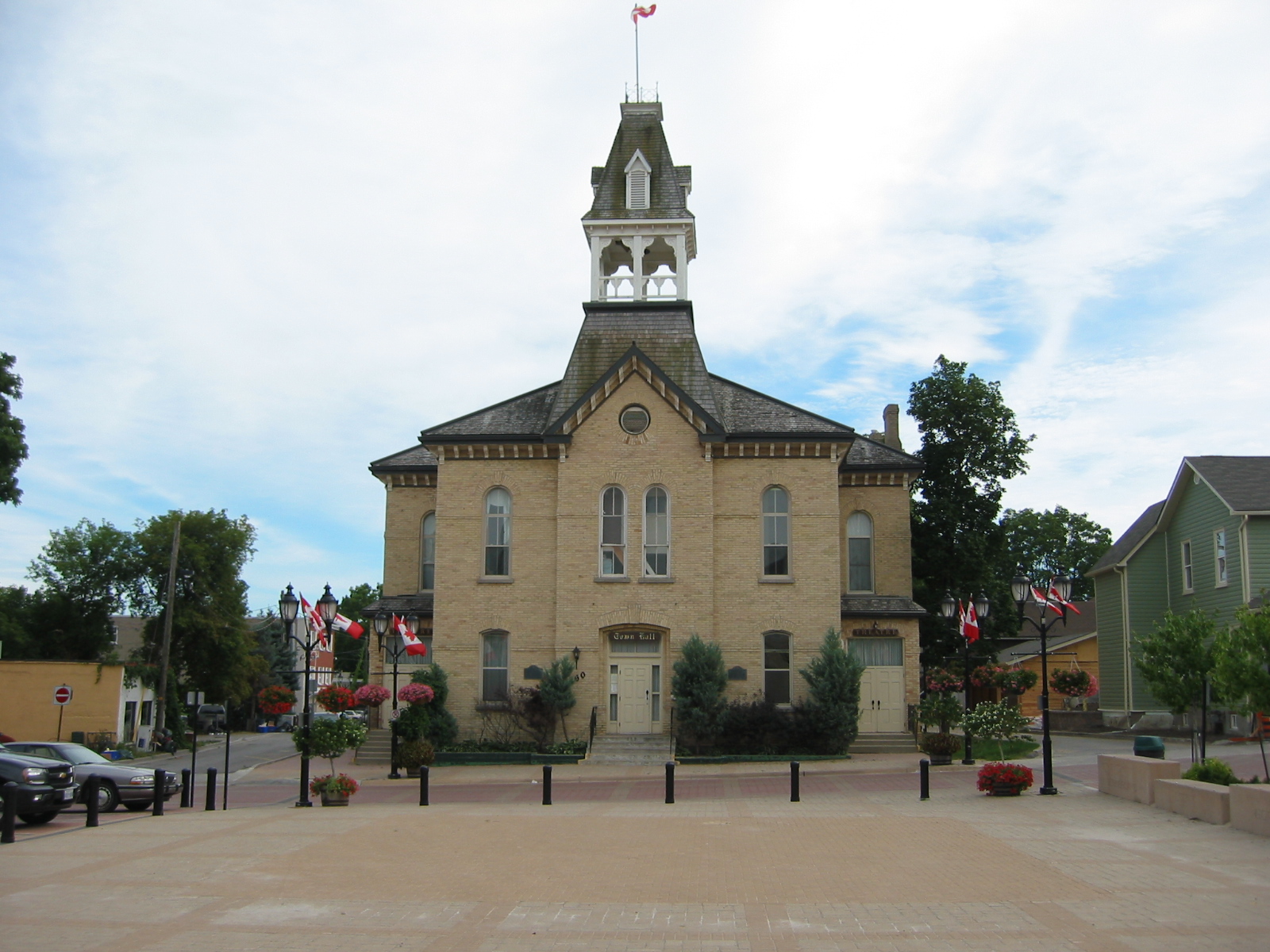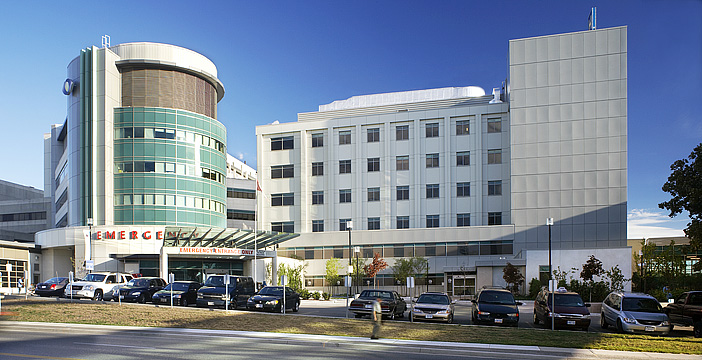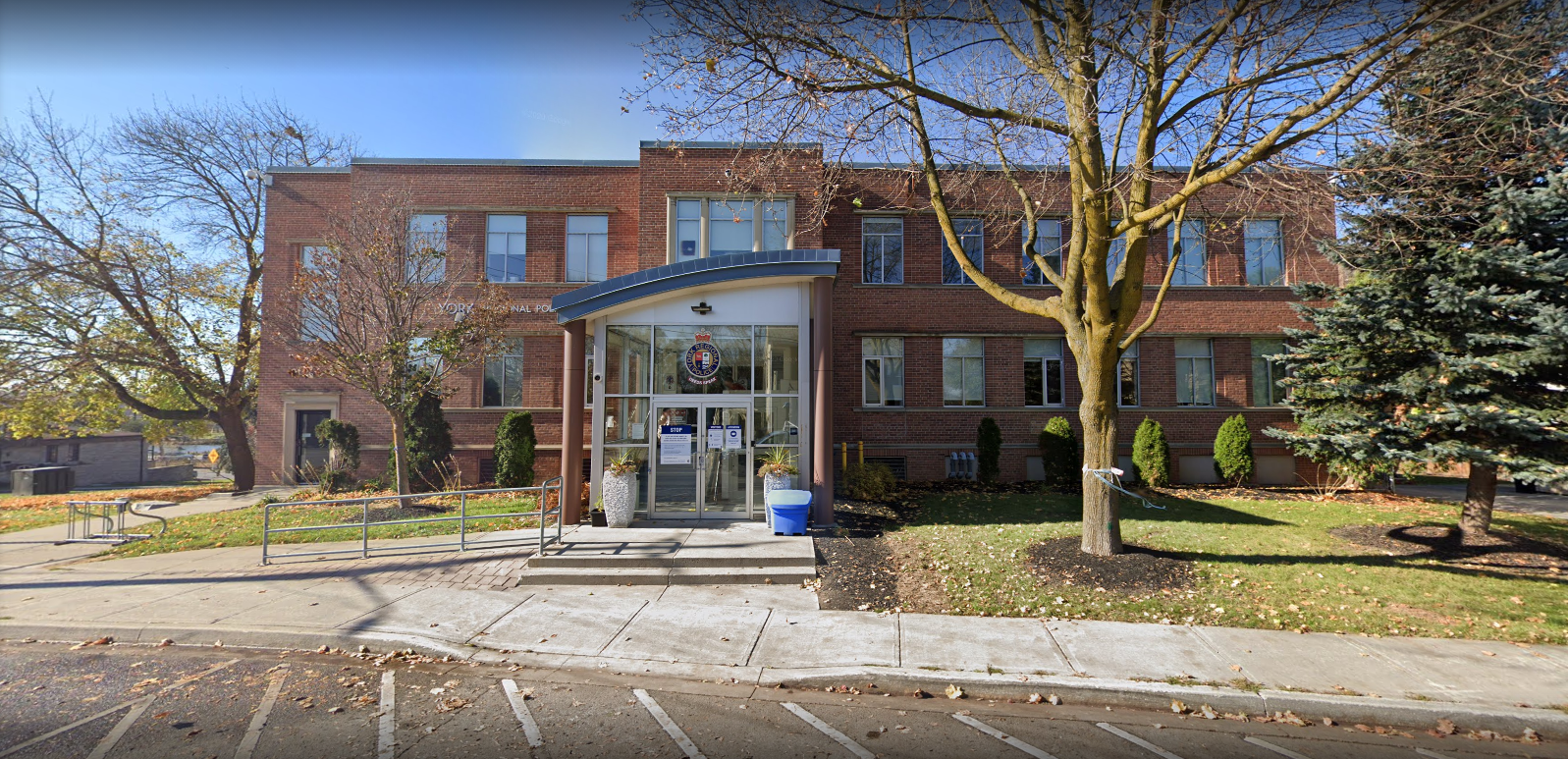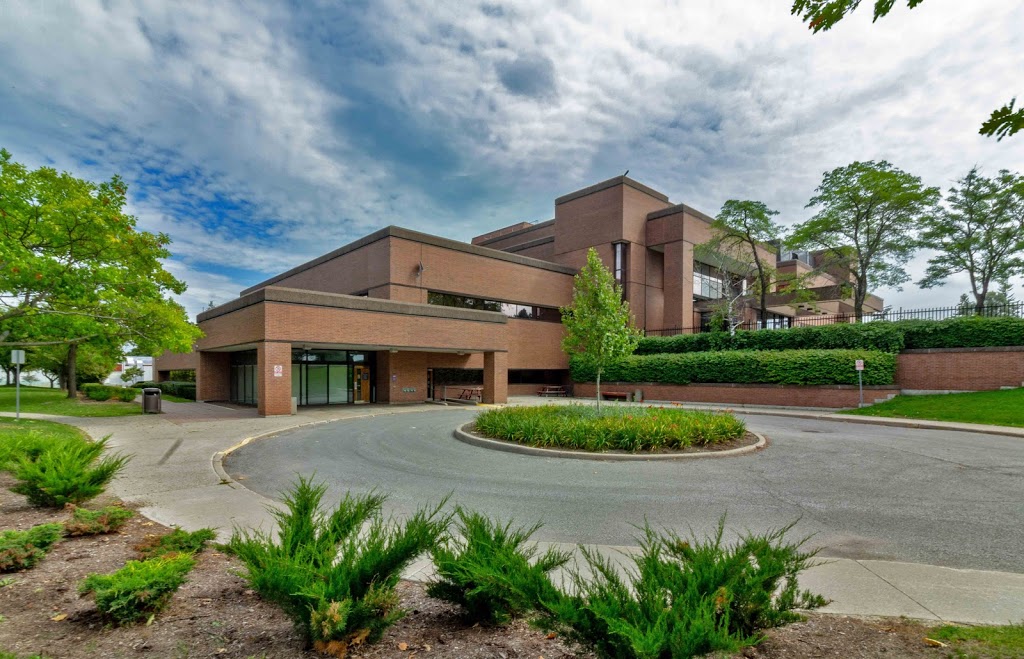Newmarket, Ontario, Canada

Newmarket’s location on the Holland River enabled travel between Lake Ontario and Lake Simcoe. A portage route, the Toronto Carrying-Place Trail, ran one of its two routes down the Holland River through the Newmarket area, and over the Oak Ridges Moraine to the Rouge River and into Lake Ontario. A more widely used route ran down the western branch of the Holland River, over the moraine, and down the Humber River. In 1793, John Graves Simcoe travelled the trail northward along the main route to the west, and south to York (now Toronto) along the lesser used eastern route through Newmarket. Selecting the eastern route as the better of the two, Simcoe started construction of Yonge Street along the former trail in late 1795, starting in York in Toronto Bay, and ending at the newly named St. Albans (Holland Landing), north of Newmarket.
In 1802, Elisha Beman, who owned land in the area, establish a mill, and then a distillery. Mordecai Millar also built mills, and Joseph Hill opened a tannery. During the War of 1812 a resident, William Roe, was hid the settlement’s gold treasury from invading American troops. The war helped the settlement prosper, as the British army purchased goods and food and hired locals to build structures.
By 1814, the settlement had two frame and several log buildings used as residences. The settlement continued to grow through the early 19th century, along with the formation of Aurora and Holland Landing. A post office opened in 1826, and until 1890 the name was spelled “New Market”.
Newmarket is noted for its role in the Rebellions of 1837–1838, and was a centre of discontent against the manipulations of the governing Family Compact. Rebel leader William Lyon Mackenzie organized a series of meetings leading to the Rebellion; the first of which, on August 3, 1837, was delivered from the veranda of the North American Hotel in Newmarket. This speech contributed to the rebellion, as it was heard by about 600 farmers and others sympathetic to Mackenzie’s cause, who later that year armed themselves and marched down Yonge Street to take the capital. A number of leaders from this area were attainted for high treason, convicted and hanged.
By 1846, the population was about 600. Much of the settlement was built on the south side of the town, with farms surrounding it. There were six churches or chapels, a post office, five stores, three taverns, and tradesmen of various types. Industry included two grist-mills, two breweries, a distillery, one tannery, a foundry, a carding machine, and a cloth factory.
In June 1853, the first train pulled into Newmarket on the Toronto, Simcoe & Lake Huron Union Railroad, the first railway in Upper Canada. It was later called the Northern Railway of Canada, and carried passengers, agricultural products and manufactured goods. The line eventually linked Toronto to Collingwood on Georgian Bay, a major shipbuilding centre. Today, this line is the “Newmarket Subdivision” of the Canadian National Railway system, running north out of Newmarket towards Bradford, and south towards Toronto.
Our Massage Therapy Services
Directions:
You need to first head south on Davis Dr/York Regional Rd 31 toward Davis Dr/York Regional Rd 31, then turn right and on the right side is the Southlake Regional Health Centre.

Southlake Regional Health Centre
Southlake Regional Health Centre (formerly York County Hospital) is a hospital located in Newmarket, Ontario, Canada. Through various expansions during its history, it has grown into a university-affiliated teaching and research facility, specifically offering advanced cardiac, cancer and thoracic care.
A private hospital[further explanation needed] was founded in 1922 and on August 22, the province granted a Charter of Incorporation for the York County Hospital Corporation. York County Hospital became a public hospital in 1924. In 1927 the new hospital building was completed by architects Craig and Madill. In 1946, the Margaret Johnson Davis Wing opened with 55 beds. In 1956, the South Wing opened and a six-storey tower opened in 1964. Capacity was increased to 420 beds with the opening of the East Wing in 1976. On September 12, 1998, the name of the hospital was changed from York County Hospital to the present name. In 1999, a project to further expand the hospital was begun
In October 2015, Southlake Regional Health Centre was once again named one of Greater Toronto’s Top 100 Employers by a company named Mediacorp Canada Inc., and published by the Toronto Star.
The hospital is connected to the Southlake Regional Cancer Centre to its west, and to a Medical Arts building by an arch bridge to its north occupied principally by University of Toronto’s Family Medicine Teaching Unit and other health services. The Stronach Regional Cancer Centre is partnered with Princess Margaret Hospital.
Directions:
First is to head north toward Davis Dr/York Regional Rd 31, then turn right onto Davis Dr/York Regional Rd 31 followed by a right turn onto Alexander Rd, then turn right onto Crusader Way and on the left is the Sacred Heart Catholic High School Trombley.

Sacred Heart Catholic High School Trombley, 908 Lemar Rd, Newmarket, ON L3Y 1R9, Canada
Sacred Heart Catholic High School is a public Catholic high school in Newmarket, Ontario, Canada. It is currently the only high school in Newmarket under the jurisdiction of the York Catholic District School Board. There were 1620 full-time registered students for the 2005/2006 year, 95 full-time staff members, and 24 support staff.
In January 1969, the York Region Separate School Board came into existence with the combining of eleven small school boards. Shortly thereafter, the Board passed a motion to Catholic High Schools in Toronto. At their next meeting, trustees faced a parents’ delegation protesting the decision. This delegation, in convincing the Board to reverse its stand, showed that support for the concept of Catholic education beyond elementary school was strong.
Thus, the Board carried on the tradition of Catholic education and continued to transport students to Catholic high schools in Metropolitan Toronto. In 1973, the Metro Separate School Board declared that these students could no longer be accommodated. Therefore, in 1974, the York Separate School Board decided to establish St. Robert Catholic High School in Thornhill, Ontario. In doing so, the Board made a statement that a second junior high school would be built north of Toronto at a future date “if the extension of Catholic education is supported by the Catholic community of York Region”.
St. Robert was a tremendous success and after four years was filled to capacity. The Board, therefore, opened the doors of Sacred Heart Junior High School in September 1979, providing 265 students with a Grades 7 to 9 program. Through the cooperative efforts of the Board and the Toronto Archdiocese High School Commission, Grade 11 was introduced in September 1981 and one grade was added each subsequent year.
Simultaneously, a building program was undertaken and beautiful new facilities were made available to students in September 1983. The student population continued to increase and a new addition to the building was opened in May 1987.
The Catholic School Council in conjunction with staff and students continue to seek improvements to the school. In 2002 two new additions were added which gave the school a new cafeteria, upgraded physical education equipment and facilities, an expanded library resource centre, a theatre/lecture hall, new administrative offices as well as guidance and special education additions.
Another major renovation took place in the summer of 2004. The entire second floor of the old wing received new Science Labs and Art Rooms.
Directions:
You must head southwest on Crusader Way toward Srigley St, then turn left onto Srigley St and then turn left onto Prospect St/York Regional Rd 34. Next is to turn right onto Water St followed by a right turn at Cotter St then do a right turn and on the right side is the York Regional Police.

York Regional Police, 240 Prospect St, Newmarket, ON L3Y 3T9, Canada
When 14 municipal police departments and the York County Security Police amalgamated to form York Regional Police on January 1, 1971, our region looked a lot different than it does today. At the time, about 200 York Regional Police members served roughly 169,000 citizens, who were grappling with the thought that they may lose their neighbourhood cop. High-ranking municipal officers were also adjusting to the idea of sacrificing their own professional stature to join a larger team – to be a part of something greater, even if that meant working as a constable or a sergeant, rather than an officer in command.
Today, our 2,300 members are proud to serve the 1.2 million residents of York Region, which has become one of Canada’s fastest-growing and most diverse communities. Our officers patrol nine unique municipalities that range from rural landscapes to urban cityscapes, ensuring that our citizens feel safe and secure through excellence in policing. Over the years we have worked closely with our community partners to promote equity and inclusion, so everyone in York Region feels that they belong.
“Over the past 50 years, we have truly evolved as an organization to meet the unique needs of our residents. Our achievements speak to the professionalism and dedication of all of our members – past and present,” said Jim MacSween Chief of Police. “As we look to the future, we are excited to work in collaboration with our community to further innovate and grow. Here’s to another 50 years of policing excellence.”
Directions:
First head south toward Water St, then turn left toward Water St followed by a right turn at the 1st cross street onto Water St, then on Water St turns left and becomes Eagle St, next is to turn left and on the left side is the Superior Court of Justice.

Superior Court of Justice, 50 Eagle St W, Newmarket, ON L3Y 6B1, Canada
The Superior Court of Justice in Ontario is unique among the courts of the province: it is a court of “inherent jurisdiction”, meaning that it does not derive its existence from legislation, as the other courts of the province do. Instead, the Superior Court’s jurisdiction is rooted in the history of the first courts of England, whose authority over government actions were based in the Magna Carta. The Superior Court of today is entrenched in our modern Canadian Constitution, guaranteeing that the Court continues its inherent and protective authority. Members of the public who engage in proceedings in the Superior Court should know that they are participating in a court process that distinctively traces its foundation to the very beginnings of the Common Law system.
The origins of the Superior Court of Justice can be traced back to the 1790s, when what is now Ontario was known as Upper Canada. At that time, the court system was based on English common law and modelled after the English system. By the 1830s, Upper Canada had a fully-functioning judicial system including superior, county and district courts, a court of equity (called the Court of Chancery), and a small claims court (called Division Court).
The common law and equity courts were merged in 1881 under the Ontario Judicature Act to create the new Supreme Court of Ontario with two branches: the High Court of Justice and the Court of Appeal. More recent milestones include the creation of the Divisional Court, which was added to the Supreme Court of Ontario in 1970, and the establishment of a province-wide District Court combining district and county courts and general sessions courts in 1985.
Directions:
First is to take Eagle St W to Yonge St/York Regional Rd 1, then head north toward Eagle St W and then turn right onto Eagle St W. Next is to drive from Bathurst St/York Regional Rd 38 to Richmond Hill, then turn right at the 1st cross street onto Yonge St/York Regional Rd 1 followed by a right turn onto Mulock Dr/York Regional Rd 74, then turn left onto Bathurst St/York Regional Rd 38. Next is to continue straight to stay on Bathurst St/York Regional Rd 38, then turn left onto Elgin Mills Rd W/York Regional Rd 49. Next is to turn right onto Yonge St/York Regional Rd 1, then continue straight to stay on Yonge St/York Regional Rd 1. To drive to your destination you have to turn right at Crosby Ave, then do a slight left followed by a left turn and on the left side is the Awesome Physiotherapy Of Richmond Hill.


